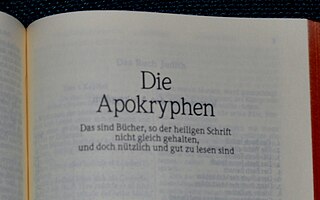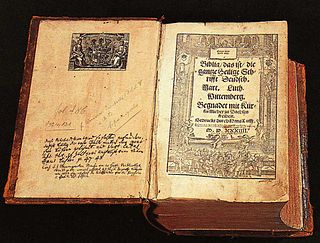Related Research Articles

The Bible is a collection of religious texts or scriptures, some, all, or a variant of which, are held to be sacred in Christianity, Judaism, Samaritanism, Islam, the Baha'i Faith, and many other Abrahamic religions. The Bible is an anthology, a compilation of texts of a variety of forms, originally written in Hebrew, Aramaic, and Koine Greek. These texts include instructions, stories, poetry, and prophecies, and other genres. The collection of materials that are accepted as part of the Bible by a particular religious tradition or community is called a biblical canon. Believers in the Bible generally consider it to be a product of divine inspiration, but the way they understand what that means and interpret the text varies.

The First Epistle to the Corinthians is one of the Pauline epistles, part of the New Testament of the Christian Bible. The epistle is attributed to Paul the Apostle and a co-author, Sosthenes, and is addressed to the Christian church in Corinth. Despite the name, it is not believed to be the first such letter. Scholars believe that Sosthenes was the amanuensis who wrote down the text of the letter at Paul's direction. It addresses various issues that had arisen in the Christian community at Corinth and is composed in a form of Koine Greek.

The King James Version (KJV), also the King James Version Bible (KJVB) and the Authorized Version (AV) is an Early Modern English translation of the Christian Bible for the Church of England, which was commissioned in 1604 and published in 1611, by sponsorship of King James VI and I. The 80 books of the King James Version include 39 books of the Old Testament, 14 books of Apocrypha, and the 27 books of the New Testament.
The New Testament (NT) is the second division of the Christian biblical canon. It discusses the teachings and person of Jesus, as well as events relating to first-century Christianity. The New Testament's background, the first division of the Christian Bible, is called the Old Testament, which is based primarily upon the Hebrew Bible; together they are regarded as sacred scripture by Christians.
Partial Bible translations into languages of the English people can be traced back to the late 7th century, including translations into Old and Middle English. More than 100 complete translations into English have been produced. A number of translations have been prepared of parts of the Bible, some deliberately limited to certain books and some projects that have been abandoned before the planned completion.
Middle English Bible translations (1066-1500) covers the age of Middle English, beginning with the Norman conquest and ending about 1500.

Wycliffe's Bible or Wycliffite Bibles or Wycliffian Bibles (WYC) are names given for a sequence of Middle English Bible translations believed to have been made under the direction or instigation of English theologian John Wycliffe of the University of Oxford. They are the earliest known literal translations of the entire Bible into English. They appeared over a period from approximately 1382 to 1395.

The Aramaic original New Testament theory is the belief that the Christian New Testament was originally written in Aramaic.

Chapter and verse divisions did not appear in the original texts of Jewish or Christian bibles; such divisions form part of the paratext of the Bible. Since the early 13th century, most copies and editions of the Bible have presented all but the shortest of the scriptural books with divisions into chapters, generally a page or so in length. Since the mid-16th century, editors have further subdivided each chapter into verses – each consisting of a few short lines or of one or more sentences. In the King James Version (KJV) Esther 8:9 is the longest verse and John 11:35 is the shortest. Sometimes a sentence spans more than one verse, as in the case of Ephesians 2:8–9, and sometimes there is more than one sentence in a single verse, as in the case of Genesis 1:2.
The Holy Bible in Modern English, commonly known as the Ferrar Fenton Bible, was an early translation of the Bible into English as spoken and written in the 19th and 20th centuries.
John Bertram Phillips or J. B. Phillips was an English Bible translator, author and Anglican clergyman. He is most noted for his The New Testament in Modern English.

The biblical apocrypha denotes the collection of apocryphal ancient books thought to have been written some time between 200 BC and AD 100. The Catholic, Eastern Orthodox and Oriental Orthodox churches include some or all of the same texts within the body of their version of the Old Testament, with Catholics terming them deuterocanonical books. Traditional 80-book Protestant Bibles include fourteen books in an intertestamental section between the Old Testament and New Testament called the Apocrypha, deeming these useful for instruction, but non-canonical. To this date, the Apocrypha are "included in the lectionaries of Anglican and Lutheran Churches". Anabaptists use the Luther Bible, which contains the Apocrypha as intertestamental books; Amish wedding ceremonies include "the retelling of the marriage of Tobias and Sarah in the Apocrypha". Moreover, the Revised Common Lectionary, in use by most mainline Protestants including Methodists and Moravians, lists readings from the Apocrypha in the liturgical calendar, although alternate Old Testament scripture lessons are provided.

Since the arrival of Christianity in China, the Bible has been translated into many varieties of the Chinese language, both in fragments and in its totality. The first translations may have been undertaken as early as the 7th century AD, but the first printed translations appeared only in the nineteenth century. Progress on a modern translation was encumbered by denominational rivalries, theological clashes, linguistic disputes, and practical challenges at least until the publication of the Protestant Chinese Union Version in 1919, which became the basis of standard versions in use today.
John Edgar McFadyen B. A. (Oxon), M. A., D. D. was a Scottish theologian, was professor of language, literature and Old Testament theology in the University of Glasgow. He was born in Glasgow and died in 1933.

The term Catholic Bible can be understood in two ways. More generally, it can refer to a Christian Bible that includes the whole 73-book canon recognized by the Catholic Church, including some of the deuterocanonical books of the Old Testament which are in the Greek Septuagint collection, but which are not present in the Hebrew Masoretic Text collection. More specifically, the term can refer to a version or translation of the Bible which is published with the Catholic Church's approval, in accordance with Catholic canon law.
Paul Ellingworth was an Honorary Professor in New Testament at the School of Divinity, History & Philosophy of the University of Aberdeen and former translation consultant for the United Bible Societies. He wrote several books on biblical matters, notably on Hebrews. He lived in Aberdeen.

Sacred Name Bibles are Bible translations that consistently use Hebraic forms of the God of Israel's personal name, instead of its English language translation, in both the Old and New Testaments. Some Bible versions, such as the Jerusalem Bible, employ the name Yahweh, a transliteration of the Hebrew tetragrammaton (YHWH), in the English text of the Old Testament, where traditional English versions have LORD.

A Protestant Bible is a Christian Bible whose translation or revision was produced by Protestant Christians. Typically translated into a vernacular language, such Bibles comprise 39 books of the Old Testament and 27 books of the New Testament, for a total of 66 books. Some Protestants use Bibles which also include 14 additional books in a section known as the Apocrypha bringing the total to 80 books. This is in contrast with the 73 books of the Catholic Bible, which includes seven deuterocanonical books as a part of the Old Testament. The division between protocanonical and deuterocanonical books is not accepted by all Protestants who simply view books as being canonical or not and therefore classify books found in the Deuterocanon, along with other books, as part of the Apocrypha. Sometimes the term "Protestant Bible" is simply used as a shorthand for a bible which contains only the 66 books of the Old and New Testaments.
Bible translations into Hebrew primarily refers to translations of the New Testament of the Christian Bible into the Hebrew language, from the original Koine Greek or an intermediate translation. There is less need to translate the Jewish Tanakh from the Original Biblical Hebrew, because it is closely intelligible to Modern Hebrew speakers. There are more translations of the small number of Tanakhas passages preserved in the more distantly related biblical Aramaic language. There are also Hebrew translations of Biblical apocrypha.
References
- 1 2 3 Who's Who, An Annual Biographical Dictionary. A & C Black. 1905. p. 531. Retrieved April 12, 2021.
- 1 2 3 The Cambridge History of the Bible: Volume 3, The West from the Reformation to the Present Day. London: Cambridge University Press. 1963. p. 375. ISBN 0-521-04254-2 . Retrieved April 14, 2021.
- 1 2 3 Fenton, Ferrar (1925). The Holy Bible in Modern English. London: S. W. Partridge & Co. Retrieved April 15, 2021.
- 1 2 3 4 5 6 Paul, William E. (2015). English Language Bible Translators. Jefferson, North Carolina: McFarland & Company. ISBN 978-0-7864-4243-0 . Retrieved April 14, 2021.
- ↑ Royal Asiatic Society of Great Britain and Ireland (1903). Journal of the Royal Asiatic Society of Great Britain & Ireland. London: Cambridge University Press . Retrieved April 14, 2021.
- 1 2 Wilson, Derek (2011). The People's Bible: The Remarkable History of the King James Version. Oxford, England: Lion Hudson. p. 171. ISBN 978-0-7459-5559-9 . Retrieved April 14, 2021.
- 1 2 Robertson, Edwin Hanton (1959). The New Translations of the Bible. London: S.C.M. Press. Retrieved April 14, 2021.